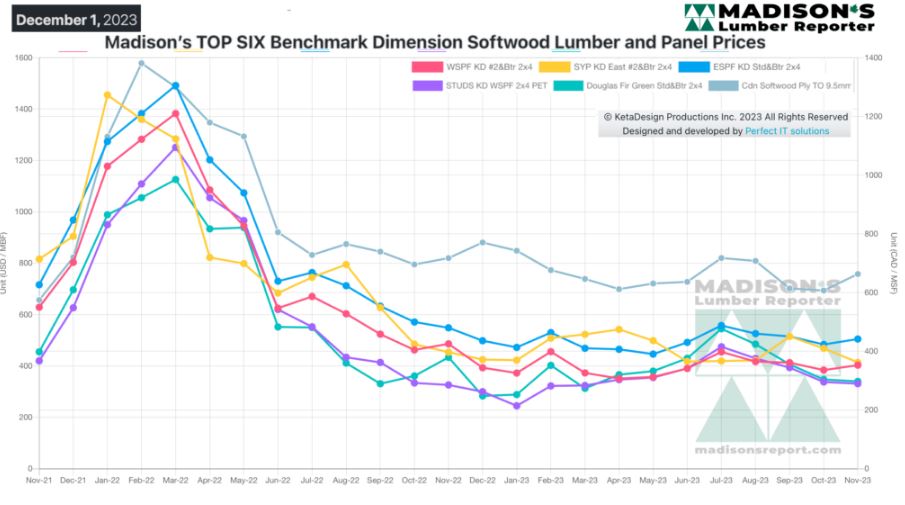 It Is Normal Toward The End Of The Year, As Construction Activity Really
Slows Down For Winter, That Lumber Sales And Lumber Prices Also Flatten Out.
It Is Normal Toward The End Of The Year, As Construction Activity Really
Slows Down For Winter, That Lumber Sales And Lumber Prices Also Flatten Out.
After three years of incredible volatility, 2023 annual lumber price cycle
seems to have returned to historical norm. Over the course of this year the
price swing between highest and lowest was approximately US$150, which is
along the lines of the past. For example, the benchmark Western S-P-F 2×4
#2&btr reached a high of US$476 mfbm in mid-February 2023, and a low of $335
in late March. This kind of normal fluctuation makes it more possible for
industry, both producers and customers alike, to plan. As we go forward into
next year, the usual processes of running a sawmill: hiring loggers,
contacting truckers, making a lumber production schedule, etc, will be less
fraught with uncertainty and confusion than it was during the past three
years.
Producers in the Western United States kept their asking prices flat almost
across the board, even as their log decks dwindled by the day – particularly
in terms of large-diameter fibre.
In the week ending December 1, 2023, the price of Western Spruce-Pine-Fir
2×4 #2&Btr KD (RL) was US$414 mfbm, which is flat from the previous week.
That week’s price is up by +$11, or +3%, from one month ago when it was
$403.
As the calendar turned to December overall sales were fair-to-middling. This
recent pullback in demand was balanced by ongoing tight supply.

Following a solid pre-Thanksgiving surge in sales early the previous week,
as December dawned demand for Western S-P-F commodities in the US appeared
to pull back noticeably. Supply of dimension items eight-inches and wider
was already tightening up as buyers came out of the woodwork to short-cover.
The ground wasn’t frozen enough yet to allow harvesting crews access to
those large stems needed for wides. Many players used the old saw “sneaky
strong” to describe the market; as supply and demand were in a deceptively
balanced state.
Both demand and supply of Western S-P-F lumber seemed to sag in tandem, to
hear Western Canadian players tell it.
Production volumes were waning for several weeks in a row. After an initial
surge in buying in early November, most customers had covered their urgent
needs and retreated to the sidelines for the remainder of the month.
Sawmills meanwhile have maintained two- to three-week order files over that
same period amid firm numbers. This with the help of quiet production
curtailments and shift adjustments, according to scuttlebutt. There was a
broad sentiment among players that, absent some exogenous factor that
severely impacts the supply side, this market is basically bottomed out for
the year. Buyers stuck to booking only small volumes of whatever prompt
material they could get their hands on, lending a subdued tone to business.
The Hemlock/Fir complex at large experienced a fairly flat week in most
respects, and green Douglas-fir commodities were no exception. With so
little production time left on the calendar, suppliers strongly recommended
their charges secure more speculative coverage through the end of 2023. Most
buyers were hesitant to commit to inventory positions that long-term, but
some were convinced.
For their part, Green Fir producers were content to maintain firm asking
prices, with their order files well into December. This put them in good
positions heading into the New Year. Heavy rain began to smite much of the
West Coast of North America, causing freight rates for green fir shipments
to inch up as that fresh wood took on moisture.

Compared To The Same Week Last Year, When It Was Us$490 Mfbm, The Price Of
Western Spruce-Pine-Fir 2×4 #2&Btr Kd (Rl) For The Week Ending November 17,
2023 Was Down By -$86, Or -18%.
Compared To Two Years Ago When It Was $620, That Week’S Price Is Down By
-$216, Or -35%.
More Reports: